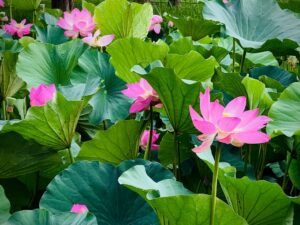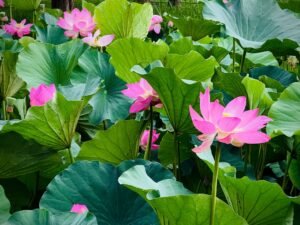

Nature’s Language: Teaching Kids English Vocabulary Inspired by the Outdoors
Language learning is an essential skill for children to develop, as it opens up a world of opportunities and helps them communicate effectively with others. However, traditional methods of language learning can sometimes be dull and uninspiring for young learners. That’s where nature comes in. By incorporating the natural world into language learning activities, children can connect with language on a deeper level and have fun while doing so.
Table of Contents
ToggleThe Importance of Nature in Language Learning for Kids
Using nature as a tool for teaching language has numerous benefits. Firstly, it provides a real-life context for children to learn and practice new vocabulary. When children are exposed to the natural world, they encounter a wide range of objects, animals, and plants that they can learn the names of in English. This helps them make connections between words and their real-world referents, making the learning process more meaningful and memorable.
Additionally, nature can help children develop a sense of wonder and curiosity about the world around them. This sense of wonder can be harnessed to engage children in language learning activities and motivate them to explore new words and concepts. By using nature as a source of inspiration, educators can tap into children’s natural curiosity and create a positive and engaging learning environment.
Using the Outdoors to Teach English Vocabulary to Children
One effective way to use nature to teach English vocabulary is through hands-on activities. For example, educators can take children on a nature walk and encourage them to collect different objects they find along the way, such as leaves, rocks, or flowers. Back in the classroom, children can then use these objects to practice new vocabulary by describing their characteristics or categorizing them based on their features.
Another idea is to create a nature-themed scavenger hunt. Educators can provide children with a list of items they need to find in nature, such as a pinecone, a bird’s nest, or a butterfly. As children search for these items, they can practice saying the names of the objects in English and engage in conversations with their peers about what they have found.
Using real-life objects in language learning has several benefits. Firstly, it makes the learning experience more tangible and concrete for children, as they can see and touch the objects they are learning about. This helps them form stronger connections between words and their meanings. Additionally, using real-life objects allows children to engage their senses, which enhances their overall learning experience.
Engaging Children with Nature’s Language: Fun Activities and Games
Incorporating games and activities into language learning can make the process more enjoyable and interactive for children. One fun activity is “Nature Bingo.” Educators can create bingo cards with pictures of different objects found in nature, such as trees, flowers, or insects. Children can then go on a nature walk and mark off the items they find on their bingo cards. This activity not only helps children practice vocabulary but also encourages them to observe and appreciate the natural world around them.
Another game that can be played is “Nature Charades.” Educators can write down different actions or behaviors commonly seen in nature, such as flying like a bird or crawling like a caterpillar. Children can then take turns acting out these actions while their peers guess what they are imitating. This game not only helps children practice vocabulary related to nature but also encourages creativity and imagination.
Using games and activities in language learning has several benefits. Firstly, it makes the learning process more enjoyable and engaging for children, which increases their motivation to participate and learn. Additionally, games and activities provide opportunities for children to practice language in a meaningful context, allowing them to apply what they have learned in a fun and interactive way.
Exploring the Natural World: Vocabulary for Plants and Animals
Teaching children vocabulary related to plants and animals is not only beneficial for language learning but also for their overall understanding of the natural world. Some examples of vocabulary related to plants include “tree,” “flower,” “leaf,” and “grass.” Educators can introduce these words through pictures, real-life objects, or even by taking children on a nature walk and pointing out different plants they encounter.
When it comes to animals, there is a wide range of vocabulary that can be taught. Some examples include “bird,” “butterfly,” “squirrel,” and “frog.” Educators can use pictures, videos, or even visits to a local zoo or wildlife sanctuary to introduce children to these words. By teaching children about the natural world, educators not only enhance their language skills but also foster a sense of appreciation and respect for the environment.
Seasons and Weather: Teaching Vocabulary through Nature

Teaching children about the seasons and weather is another way to incorporate nature into language learning. Vocabulary related to seasons includes words such as “spring,” “summer,” “autumn,” and “winter.” Educators can teach these words by discussing the characteristics of each season, showing pictures or videos of different seasonal activities, or even by taking children on a nature walk and pointing out signs of the current season.
When it comes to weather vocabulary, there are numerous words that can be taught, such as “sunny,” “cloudy,” “rainy,” and “windy.” Educators can introduce these words by discussing different types of weather and their characteristics, showing pictures or videos of different weather conditions, or even by engaging children in weather-related experiments or observations.
Teaching children about the seasons and weather not only helps them expand their vocabulary but also enhances their understanding of the natural world. By connecting language learning with real-life experiences, educators can make the learning process more meaningful and engaging for children.
The Power of Observation: Developing Language Skills through Nature Walks
Nature walks provide an excellent opportunity for children to develop their language skills while exploring the natural world. During a nature walk, children can observe and describe the objects, plants, and animals they encounter, practice using descriptive language, and engage in conversations with their peers and educators.
To make the most of a nature walk for language learning, educators can provide children with a list of specific things to observe or find, such as different types of leaves, insects, or animal tracks. As children explore and make observations, educators can encourage them to use descriptive language to talk about what they see. For example, children can describe the color, shape, size, or texture of a leaf they find.
Additionally, educators can engage children in conversations about their observations. They can ask open-ended questions such as “What do you think this insect is doing?” or “Why do you think this plant has thorns?” These types of questions encourage children to think critically and express their thoughts and ideas in English.
Nature walks not only provide a rich context for language learning but also offer numerous benefits for children’s overall development. They promote physical activity, sensory exploration, and a sense of connection with the natural world. By incorporating language learning into nature walks, educators can create a holistic learning experience that engages children’s minds and bodies.
Environmental Awareness: Teaching Kids English Vocabulary for Sustainability
Teaching children about sustainability is crucial in today’s world. By introducing them to vocabulary related to sustainability, educators can help children understand the importance of taking care of the environment and inspire them to become responsible global citizens.
Some examples of vocabulary related to sustainability include “recycle,” “reduce,” “reuse,” “compost,” and “energy conservation.” Educators can introduce these words through discussions about environmental issues, showing pictures or videos of sustainable practices, or even by engaging children in hands-on activities such as recycling projects or energy-saving experiments.
Teaching children about sustainability not only expands their vocabulary but also fosters a sense of responsibility and empathy towards the environment. By connecting language learning with real-world issues, educators can empower children to make a positive impact on the world around them.
Nature-inspired Art and Crafts: Enhancing Vocabulary and Creativity
Art and crafts activities inspired by nature can be a powerful tool for enhancing vocabulary and creativity in language learning. By engaging children in hands-on art projects, educators can provide them with opportunities to practice new vocabulary, express their ideas, and develop their fine motor skills.
Some examples of nature-inspired art and crafts activities include leaf rubbings, flower collages, or even creating animal masks using recycled materials. During these activities, educators can encourage children to describe the objects they are working with, use descriptive language to talk about their creations, and engage in conversations with their peers about their artwork.
Using art and crafts in language learning has several benefits. Firstly, it allows children to engage their senses and express their ideas in a creative and hands-on way. This helps them make stronger connections between words and their meanings. Additionally, art and crafts activities provide opportunities for children to collaborate with their peers, practice social skills, and develop their creativity.
Storytelling with Nature: Using the Outdoors to Teach English Grammar and Syntax
Storytelling is a powerful tool for teaching grammar and syntax in language learning. By using nature as a backdrop for storytelling activities, educators can create a rich and engaging learning experience for children.
One idea is to take children on a nature walk and encourage them to observe their surroundings carefully. Back in the classroom, educators can guide children in creating a story based on what they saw during the nature walk. Children can take turns adding sentences or paragraphs to the story, practicing grammar structures and sentence construction as they go.
Another idea is to use pictures or videos of different natural landscapes or animals as prompts for storytelling activities. Educators can show a picture or video and ask children to create a story based on what they see. This activity not only helps children practice grammar and syntax but also encourages their creativity and imagination.
Using storytelling in language learning has several benefits. Firstly, it provides a meaningful context for children to practice grammar and syntax, as they are using language to create a story with a clear purpose. Additionally, storytelling activities promote critical thinking, problem-solving, and collaboration skills.
Connecting with Nature: Fostering a Love for Language and the Environment
Fostering a love for language and the environment is essential for children’s overall development. By connecting children with nature and language, educators can create a positive and meaningful learning experience that inspires children to explore, learn, and care for the world around them.
One way to foster a love for language and the environment is by providing children with opportunities to engage with nature on a regular basis. Educators can incorporate nature walks, outdoor playtime, or even gardening activities into their language learning curriculum. By spending time in nature, children can develop a sense of connection and appreciation for the natural world, which can enhance their motivation to learn and use language.
Another way to foster a love for language and the environment is by incorporating environmental themes into language learning activities. Educators can introduce children to books, songs, or videos that promote environmental awareness and sustainability. By discussing these themes in the classroom, educators can help children understand the importance of taking care of the environment and inspire them to make positive changes in their own lives.
Incorporating nature into language learning activities has numerous benefits for children. It provides a real-life context for learning new vocabulary, enhances children’s sense of wonder and curiosity about the world, and fosters a love for language and the environment. By using nature as a tool for teaching language, educators can create engaging and meaningful learning experiences that inspire children to explore, learn, and care for the world around them. So why not step outside and let nature be your classroom?
If you want to learn English, you can register for classes here. We look forward to hearing from you and helping you become fluent in English!
If you want to learn Norwegian, you can register for classes here. We look forward to hearing from you and helping you become fluent in Norwegian.





